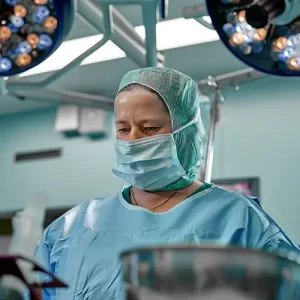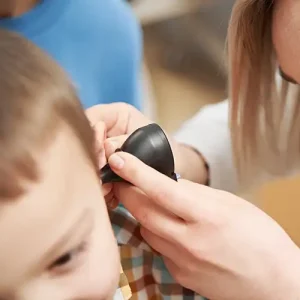Septoplasty is a surgical procedure designed to straighten a deviated nasal septum. A deviated septum is a common cause of a long-term blocked nose and breathing difficulties, making it hard to get enough airflow through one or both nostrils.
When the septum (the thin wall of cartilage and bone that divides the nasal cavity into two passages) is crooked or displaced, it can narrow one or both nasal passages. This leads to nasal obstruction, breathing difficulties, and sometimes snoring or sleep disturbance.
By correcting the septum, septoplasty can restore a more open airway, improve breathing and reduce the symptoms of nasal blockage, sinus infections and in some cases of obstructive sleep apnoea.
The septoplasty procedure is often combined with other nasal surgeries, such as turbinoplasty or sinus surgery, to address multiple causes of nasal obstruction at the same time.


A deviated nasal septum occurs when the thin wall dividing the nostrils is off-centre or crooked. This can cause one nasal passage to be narrower than the other, leading to persistent congestion, difficulty breathing and uneven airflow during exercise or sleep. Deviated septum surgery will straighten the bent nasal septum, restoring a more open airway and improving overall nasal function.
Long-term nasal blockage that doesn’t respond to medications, nasal sprays or allergy treatments may be caused by structural issues like a deviated septum. Chronic obstruction can make the daily activities of sleeping, exercising and concentrating more difficult. Septoplasty can remove the underlying structural barrier, helping patients breathe and live more comfortably.
A deviated septum can disrupt normal sinus drainage, trapping mucus and creating an environment where bacteria thrive. This may lead to repeated sinus infections, pressure and facial discomfort. By correcting the septal deviation, septoplasty can improve sinus ventilation and reduce the frequency of infections, supporting better long-term sinus health.
When the septum is uneven or sharply angled, it can irritate the delicate lining of the nose, causing frequent nosebleeds. Septoplasty can correct the deviation, smoothing the nasal passages and reducing trauma to the lining. The result of this procedure often decreases the occurrence of nosebleeds.
A deviated septum can contribute to snoring or mild sleep disturbances by partially blocking airflow at night. In some cases, this may worsen symptoms of obstructive sleep apnoea. Septoplasty can improve airflow through the nose, making breathing easier during sleep and helping patients get more restful, uninterrupted sleep.
Severe septal deviations can press against nearby nasal and sinus structures, sometimes causing persistent facial pressure or headaches. By realigning the septum, septoplasty can relieve the abnormal pressure, helping to reduce discomfort and improve your quality of life.

Septoplasty is usually recommended when a structural issue in the nose is causing persistent symptoms that have not improved with medical treatments.
We often manage nasal allergies with medication and immunotherapy first, and only consider septoplasty when allergy treatment cannot fully relieve persistent obstruction. Before considering surgery, patients may try alternative approaches such as:
While these treatments can help with inflammation, congestion and minor obstruction, they cannot correct a deviated septum. When nasal obstruction, chronic congestion, recurrent sinus infections, frequent nosebleeds or sleep-related breathing problems persist despite these measures, septoplasty may be the most effective long-term solution. If the inferior turbinates are also enlarged, we commonly address them at the same time (with turbinoplasty surgery) to maximise improvement in breathing.
Septoplasty is also considered when a deviated septum contributes to symptoms such as facial pressure, headaches or disrupted sleep.
Before recommending septoplasty, we perform a full assessment to identify the exact cause of your symptoms. This may include a clinical nasal examination and nasal endoscopy to visualise the septum and nasal passages; imaging (via a CT scan) may also be required when sinus disease or complex anatomy is suspected.
Septoplasty vs Rhinoplasty
While some patients want to know what’s better for them, the reality is that septoplasty can be combined with rhinoplasty. Generally, on its own, septoplasty does not change your nose shape. Rhinoplasty is the procedure used to change the shape or appearance of the nose. When these procedures are performed together, surgeons can correct the septal deviation to improve breathing while also refining the nasal tip, reducing a hump or adjusting the overall nasal contour. Cartilage grafts may be used to support the nose and maintain both shape and long-term function. This combined approach, often called septorhinoplasty, allows patients to achieve both functional and aesthetic improvements in a single surgery.
Septoplasty is usually performed under general anaesthetic, although some cases may be done under local anaesthetic with sedation. Septoplasty corrects a bent or misshapen septal cartilage (and sometimes nasal bone), gently reshaping or removing the distorted tissue to open the nasal airway.
Your surgeon will make a small incision inside the nose to access the septum. Any bent or misshapen portions of cartilage and bone are carefully reshaped or removed.
An endoscopic approach may be used, where a slim camera provides a detailed view of the nasal passages, allowing for precise correction with minimal disruption to surrounding tissues. The primary goal is always to improve airflow and breathing while maintaining the structural support of the nose.
The procedure is typically a day operation, taking approximately 30–90 minutes (depending on complexity and whether other procedures are combined). Most patients are able to go home the same day.

Septoplasty is typically a day procedure, meaning you can go home the same day. During recovery, you may have internal splints or soft packing to support the septum while it heals. The delicate nasal tissues heal gradually, and saline rinses may be required to help prevent crusting and support mucosal recovery. Throughout the healing process, you may experience some swelling, congestion and mild discomfort across the forehead, cheeks and upper teeth. This is considered quite normal and usually settles within a week or two.
To aid healing, patients are advised to:
Most patients recover smoothly after septoplasty, but it’s important to know the signs that require medical attention. You should contact your GP or ENT surgeon promptly if you experience:
Contact us if you develop persistent crusting, a new whistling noise when you breathe, or recurrent nasal bleeding, as these can be signs of septal perforation and warrant prompt review.
Even when symptoms seem minor, it’s always best to contact your surgeon for reassurance. Prompt attention can prevent complications and help ensure a smooth recovery.
At Complete ENT, our experienced surgeons have the expertise to assess, diagnose and recommend whether septoplasty is the right solution for your nasal airway obstruction. With advanced skills in both functional and cosmetic nasal procedures, we can safely perform septoplasty to correct a deviated septum, relieve a blocked nose and improve overall nasal breathing.
Our team is dedicated to personalised care, taking the time to discuss your symptoms, treatment options and expected outcomes so you can make an informed decision with confidence. When septoplasty is combined with rhinoplasty, we can also achieve precise cosmetic refinements while achieving optimal nasal function.
With Complete ENT, you can trust that your surgery is in capable hands. Our goal is always to help you breathe better, sleep better and enjoy a higher quality of life.


Call us on
07 3905 5999